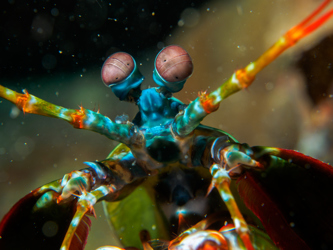What Can We Learn About Light From The Mantis Shrimp?

By Abby Proch, former editor

It’s been nearly 10 years to the day since I first learned of its existence, and I’m still awed by the mantis shrimp. Let me explain.
A few weeks ago, I attended a lecture at the Carnegie Library of Pittsburgh given by journalist, producer, composer, and podcast host Jad Abumrad. You might know him as the former host of the long-running Radiolab podcast who deftly wove together the wonders of the sciences and the humanities. During his talk that ranged from editorial best practices to how various sociocultural groups use language differently when discussing climate change (or global warming, if you so prefer), he mentioned a particular episode on the visual acuity of mantis shrimp. Now, I’m no Radiolab groupie but I found myself giddy at the fact I’d heard — and been fascinated by — this very episode.
In it, he and fellow host Robert Krulwich were exploring the origins of color. They interviewed a handful of folks, starting with a historian recounting the scientific musings of a young Sir Isaac Newton. Apparently, having been relegated to his bedroom during an uptick in the plague, Newton pondered how color came to be. He reportedly went so far as to stick a knife in the back of his eye as an odd and highly unrecommended experiment to see whether color was determined externally or internally.
Having saw nothing but a few spots dancing around, he soon followed that experiment with something more mundane when he held a prism up to sunlight filtered through a hole in his bedroom curtain. When the prism broke the white light into its rainbow of constituent colors, Newton called this “a colored image of the sun.” Still itching to know more, he then diffracted a blue column of light, still getting just more blue light. In doing so, he confirmed his belief that colors are a constituent of white light and thereby discredited the longstanding belief that light was an emanation from God or nature and that prisms only marred it, not revealed its true composition.
In the field of photonics, we understand light to be externally defined — certain wavelengths determine certain colors. But what others still argue to this day is that while that is true, the way colors are perceived might also be determined internally. And that means there’s no perfect and objective definition of color.
With his bedroom experiment, Newton also wholly upset poet John Keats, who called out Newton for stripping the romance from rainbows. More than 500 years later, however, I think we can safely agree that given all we now know about light and color, rainbows are eternally fascinating. And as I’m sure we’ve all pondered, especially given our immersion in the study of light, could a “rainbow” be made of much more than our friend Roy G. Biv?
Abumrad and Krulwich then brought on two scientists to see the rainbow, so to speak, through other creatures’ eyes. To summarize, we learned that dogs have just two photoreceptors, and so only see black, white, blue, and green, with a little bit of yellow. Humans come next with three photoreceptors — having added red to the mix — and therefore see the spectrum of ROYGBiV. Although adding another receptor doesn’t seem all that impressive, just one receptor represents about 98 more color variations in this particular comparison, they said.
Now, consider having five, six, or even 16 photoreceptors.
And that’s where the mantis shrimp comes in. An incredibly colorful creature — at least, as far our feeble eyes are concerned — the mantis shrimp is a violent crustacean that cruises clear, shallow ocean water for prey. Incredibly, with a visual system 50% more complicated than any known animal, the mantis shrimp can see red — about the same wavelength as us — all the way into the ultra-ultraviolet light. Paradoxically, with brains so puny and with such a singular focus on kill-or-be-killed, mantis shrimp likely don’t “enjoy” the kaleidoscope of color they’re privy to, say scientists.
From Newton’s experiment tackling the origins of color, we learn two things: Don’t stick a knife in your eye to “see where colors come from,” and the study of light is ever-evolving and always forward-reaching. A prism — something my daughter had recently toyed with during a “light science” week at daycare (incredible, right?) — had once been this very new and not fully understood piece of “technology.” Consider where we are now. What is today’s prism, and how will we reflect on it generations from now?
And what is to be learned from the mantis shrimp? For one, violence gets you nowhere. Except maybe if you’re a mantis shrimp trying to stay alive. And secondly, use your gifts to your potential. That goes for mantis shrimp — and the scientist who study them. At the time of this episode, scientists understood the shrimp’s visual capacity for color and the actual use of color vision as somewhat imbalanced, having hinted that the mantis shrimp don’t use their wide spectrum to the best of their ability. Years later, we’ve come to understand their ability to see cancer cells as scientists continue to reach the extent of the mantis shrimp’s visual limitations.
To hear the full episode called “Rippin’ the Rainbow a New One,” as well as other stories on the science behind color, visit the Radiolab website. To learn more from the mantis shrimp and how it taps into the electromagnetic spectrum for more than survival, check out the further research from the University of Queensland.
